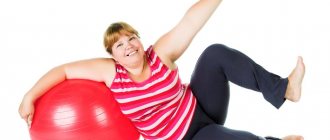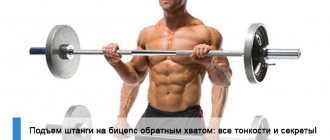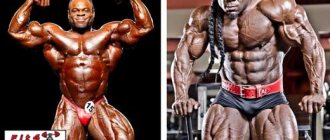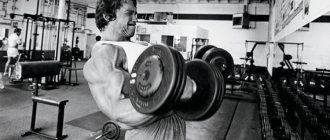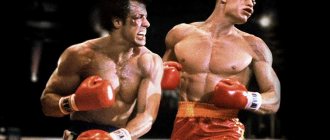What to do if your arms don't grow? The most important thing is not to let them down. According to sports science, the lag in the development of a muscle is dictated by the genetic weakness of one or another of its bundles. A weak triceps is always a weak long bundle.
A weak biceps is a weakened internal bundle. Eliminate the imbalance of muscle bundles and you will have a direct path to building extreme mass in a previously “difficult” muscle. But not earlier!
However, it is not enough to fervently bomb “weak” beams. Think for yourself, because they are deprived of growth potential. A dashing cavalry charge will immediately choke here. How to be? Let's figure it out. To do this, we will use the advice of some pros in this matter and structure our article in the form of a question and answer. Go.
George Farrah
- How do your hands grow?
Now things are going well with this, but before they grew extremely poorly for me.
— What mistakes did you make at the very beginning of hand training?
I tried to copy the complexes of champions and, in addition, trained my arms with very heavy weights. I sincerely thought that heavy weights were the key to success. As a result, I had quite a few injuries and my elbows constantly hurt. However, the volume of hands still practically did not grow.
— What helped you make a breakthrough?
I started alternating between the two types of training. On one, I pumped my arms with a low number of repetitions and significant weights, and on the other, with small weights, but with a large number of repetitions. This helped somewhat, but I noticed that I only felt the pump when working with light weights. Then it dawned on me that light weights and high repetitions were exactly what my arms needed. Since then I have been guided only by the feeling of pumping. This can be called instinctive training. I do the exercise until I feel that arm pumping has reached its limit.
I never know in advance how many sets I will have. However, the general rule is: a lot of repetitions and a lot of sets. My second discovery is the variety of training. I don't teach two identical classes. If yesterday I did biceps curls with a barbell, then next time I will do curls with dumbbells. In addition, I constantly change the angles of application of the load, while always maintaining ideal technique. Sometimes I spend several hours in the gym doing different variations of the same exercises. This gives incredible pumping.
I tried to pump up my arms after training large muscle groups, but this path is not for me. So today I do triceps and biceps on the same day, but I always start with the triceps. The secret is that working on the biceps causes me to pump my forearms very much, and my swollen forearms then prevent me from doing triceps exercises.
— How do you pump your triceps?
I combine high rep training with medium weights and training with relatively heavy weights. I start with 16-18 reps per set and end with 8-10 reps. Let me make a reservation right away that a short rest interval (no longer than 60 seconds) is much more important than a specific selection of exercises. If you rest more, the blood will leave the triceps and the next set will not give a good pump.
I don't usually do the traditional downward press. I press my back against the counter of the block machine. This provides the exercise with a higher degree of isolation. Some people do this exercise in short bursts. Well, I try to make the amplitude as wide as possible and raise the handle to the level of the temples, not lower.
— How do you pump your biceps?
I've found that I get great results from concentrated drop sets. First I do 4-5 concentrated lifts with 30kg dumbbells, then I take a 25kg dumbbell and do another 4-5 reps. Then comes the turn of 20 kg dumbbells - until “failure”. Then I do standing ups. The main thing here is to exclude any cheating. You need to relax your shoulder girdle and lower your shoulders, inhale powerfully and statically tense your back.
Today, my standard workout includes 9 sets for triceps and 6-7 for biceps. However, periodically I do shake-out days where I shake my arms for several hours at a time.
Peter Putman
- How do your hands grow?
The arms grow very slowly and cannot be compared with the chest and legs.
— What mistakes did you make at the very beginning of hand training?
At first, I did one intense set for all muscle groups, including my arms. The mass actually grew quite well, but there was a problem with the arms. The system didn't work. The reason, as I understand it, is that lagging muscles require a large amount of training and more frequent training.
— What helped you make a breakthrough?
If some muscle lags behind you, you usually don’t feel it. So I was doing biceps curls, but I didn’t feel the biceps itself working. Eventually I dropped the weights a lot and began to develop what is called "muscle feel." The weights, I repeat, were not heavy at all at first, but it was they that helped me create a real “brain-biceps” connection. This cannot be achieved with heavy weights. When you lift with a heavy barbell, your goal is to pull the weight out, not to feel the biceps work.
In addition, I abandoned the split scheme that is adopted in the one-set system. There the biceps are pumped with the back, and the biceps with the chest. Personally, this system does not suit me. So I gave my arms a separate training day. However, lagging muscles need at least two workouts per week. Therefore, I do one more “easy” workout for biceps and triceps. This is where I considered it reasonable to return to the previous scheme. Since back work loads the biceps, after training my back I do a couple of sets of 10-15 reps for the biceps. Same thing with the triceps. It fills with blood during chest training. Therefore, at the end of the chest workout, I do a couple of sets for the triceps, also 10-15 reps.
Well, I also invented my own biceps training system. I call it workouts A and B. I alternate them on arm day. Workout A includes 3 exercises. This is a standard workout aimed at increasing the overall size of the biceps. As for training B, here I use completely different exercises, experimenting with angles and load. The biceps cannot adapt to such training and therefore grows.
— How do you pump your biceps?
I do standing bicep curls with a straight bar. This is the best exercise for the biceps because it develops its largest internal bundle. Then I do one-arm Scott sit-ups. This is a killer isolation move. This is my “main” workout A. Other workouts include bicep curls, cable curls, etc. Every time I change the exercises themselves and their order.
— How do you pump your triceps?
I start my workout with an exercise that develops the most massive long triceps bundle - this is the French bench press. Next come overhead arm extensions with an EZ bar and downward presses. Moreover, the last exercise should give maximum pumping. I do 15 close-grip presses followed by 15 wide-grip presses and 15 more reverse-grip presses.
Iron Health
Very often I heard complaints from beginners that their hands did not want to grow at all. Neither strength training nor high-repetition training helped. Pumping also did not bring the desired result. Even specialized arm training twice a week did not help. Why is that? Let's figure it out.
The main reason is overtraining
In order to hit any muscle group, you really need specialized training, for example, training the target muscle group twice a week. This training method forces the body to activate hidden reserves, which provide a powerful impetus for growth. However, these reserves of organisms are not limitless. They all end sooner or later. That is why it is not recommended to delay specialization programs longer than 2-2.5 months. Otherwise, overtraining will almost certainly occur and there will be no further progress. Most likely, it is for this reason that specialized shock complexes do not help beginner athletes. At first, the program gives a good effect, and the athlete deliberately extends its period. However, after such intense loads, decline and stagnation occurs quite quickly.
What should I do?
First, if your arms are overtrained, give them a rest for a couple of weeks. During this time, all toxins will be removed from them and the cells will again accumulate energy.
Secondly, after such a rest, get ready to pump your arms once a week. In addition, you will have to reduce the number of working approaches - up to 20 sets per week. The rest time between approaches, on the contrary, should be increased to 2 minutes (instead of the previous 45 seconds).
With regards to the use of Joe Weider's principles, namely the use of supersets, drop sets, stepped sets and sets to failure, they should not be applied everywhere. Excessive increases in intensity are more likely to lead to overtraining than to give a new impetus to muscle growth.
In general, it is recommended to use drop sets and so on only when you yourself feel a surge of strength. In short, apply Wider's principles according to your mood. Any of these techniques can be equated to setting a strength record, and, you see, records are not set every day.
It may seem that my advice is aimed at reducing the intensity of training, but in practice you will see that the working weights will increase. And this is a sure sign that there will soon be an increase in muscle mass.
In conclusion, I want to offer you a training program for your hands, taking into account all the above tips. This complex will help bring your hands out of stagnation and create a foundation for further growth.
| Exercises | Approaches | Repetitions |
| Standing biceps curl | 4 | 8-10 |
| Alternating biceps curls | 3 | 10-12 |
| "Hammer" | 4 | 10-12 |
| French bench press | 4 | 8-10 |
| Press down | 3 | 10-12 |
| Extension of arms from behind the head | 2 | 10-12 |
| Dips | 2 | 12-15 |
- Rest between sets for at least 2 minutes;
- Drop sets, forced reps, etc. do it according to your mood.
Video on the topic : “Arm training and posing”
Fuad Abid
- How do your hands grow?
I can’t say that my hands are my strength. I started training with my arms at 32 cm.
— What mistakes did you make at the very beginning of hand training?
I didn't bother to understand the anatomy of the biceps and triceps bands, so I didn't know how the different exercises worked. As a result, I did a lot of stupid work, loaded the same bunch with exercises, and left others without any work at all.
— What helped you make a breakthrough?
Self-education. I started reading the literature and asking questions. As a result, I stopped training biceps and triceps together with large muscle groups. I dedicated an entire training day to my arms and it immediately increased the intensity of the training. Previously, I loaded the biceps after the back and it was a clear hack. I mechanically finished off set after set without feeling my biceps. Well, now I’ve figured out exactly how to bomb different beams and I feel not only the work of the muscle itself, but even the work of a separate beam.
In addition, I discovered that my hands grow well from negativity. So now I perform the last third set of any exercise with an emphasis on the negative phase. In fact, I always do three sets per exercise for biceps and triceps. But this does not mean that I train monotonously. I discovered that you need to train your arms cyclically. I load my arms for two weeks, doing 8-10 reps per set, and then reduce the working weights and do sets of 10-12 reps for two weeks. Then I return to the beginning of the cycle. In any case, hands need variety. Some people change the exercises, but personally this method does not suit me. When I do the same exercise for a long time, I concentrate on it better and better.
— How do you pump your triceps?
I am convinced that it is not the exercises themselves that work, but the right combination of them. You do the first exercise and it should sharpen the impact of the second even more. Not every combination of exercises works this way. I start bombing my triceps with French presses until failure, and then immediately do narrow bench presses. I start with 80 kg for 12-15 repetitions, then increase the weight and do 6-8 repetitions. Then comes the downward press with a cable handle and one-arm overhead extension with a dumbbell.
— How do you pump your biceps?
The most important thing here is to do lifts only with a straight bar. A curved bar is absolutely not suitable because it does not provide load to the most massive internal beam. You need to equally fanatically “inflate” the muscle that lies under the biceps. Personally, I do hammer and standing raises with a reverse grip until I completely pass out.
Mike Ergaz
- How do your hands grow?
It’s not enough to say that at first they didn’t grow at all. It took me many years to bring them into harmony with other muscle groups.
— What mistakes did you make at the very beginning of hand training?
From the first day I started training in a strength style. The most important thing for me was to overcome the weight, even at the cost of breaking my technique. This approach works well for large muscle groups, but it was fatal for my arms. The strength of the hands grew, but the volumes “froze” tightly. It seemed to me that the problem was the low intensity of the training and I increased the weight even more. I’m still surprised how I didn’t get seriously injured. As a result, I found myself in a dead end: my arms were monstrously strong, but their volume did not exceed 46 cm. However, I could not decide to change my training style.
— What helped you make a breakthrough?
Two years passed before I first did the usual 6-8 repetitions, as many as 12. It turned out that this number of repetitions gives me a much greater pump. I continued the experiment and eventually found the most optimal number of repetitions for myself - 15-20 per set. But the number of sets had to be increased. Now I have not 2-3, but 12 sets for biceps and the same number for triceps. Frankly, these were completely new sensations for me, because for the first time in many years of strength work, a “brain-muscle” connection began to form.
I began to feel the work of my arm muscles and this pushed me to new experiments. First of all, I realized that I needed to stop pumping up my arms with large muscle groups. I gave my hands a separate workout. Then I experimented with tempo, cyclic loads, negatives, forced repetitions and other principles of bodybuilding. In short, I got down to the main thing - I started searching for “my” methodology.
— How do you pump your triceps?
I do the exercise very slowly with full concentration of consciousness. As a result, I reach a severe burning sensation in my triceps. For me this is a sign of proper work. As for the exercises, I start with presses, then do close grip presses, French bench presses and dips. I agree that training should be varied, however, in my opinion, a variety of loads may well replace deep concentration on the exercise. This is what makes the movement effective. If there is no concentration, there is no return. I’ve been pumping triceps with the same complex for many years now and noticing the progress.
— How do you pump your biceps?
When pumping up your biceps, you need to avoid cheating. This is counterproductive. The biceps curl should remain an isolated exercise that is done with the strength of the biceps alone. What's the point of throwing the barbell up using your entire body? To avoid cheating, do your lifts extremely slowly. Here's my biceps routine: standing barbell curls, seated dumbbell curls, standing hammer, or one-arm hammer on a Scott bench. This selection of exercises is explained simply. Since two muscles bend the elbow at once - the biceps and the brachioradialis muscle, I load both muscles equally.
Everything described below is based on personal experience and observations.
Do hardgainers need arm training?
There are 2 opposing opinions on this matter. First: don’t train your arms at all - they already receive enough load when doing basic exercises on the chest, shoulders, and back. Second opinion: you need to train your hands.
Observations show that the second opinion is correct. Guys who do arm exercises progress faster. Including bench presses and rows. The fact is that the arms are often the weak link in rows, pull-ups, presses, etc. And more developed arms allow you to train with more weight in basic exercises, which has a positive effect on overall development.
Typical mistakes in training the arms of Hargainers
When starting to train their arms, hardgainers often find that they stop growing. The most common mistake is overtraining the hands. This happens because there is excess load on the hands. For example, an athlete performs 4 sets of bent-over barbell rows, 4 sets of bench presses (in which the arms are intensively worked), and then enthusiastically does 4 more sets of barbell curls and 4 sets of French presses. In total, we get 8 approaches in which the biceps are worked (4 points of barbell rows + 4 points of barbell lifts) and 8 for triceps (4 points of bench press + 4 points of bench press). In this case, only 4 approaches fall on the back and chest. That is, we see an obvious imbalance. The arms, which have small muscles, receive more stress than the large chest and back. The result is that my hands are overworked.
The second variant of arm overtraining is associated with frequent (2-3 times a week, and sometimes more often) arm training. In my opinion, every jock goes through this. As a result, the arm muscles do not have time not only to grow, but even to recover. Don't forget that they also have to work on exercises for the chest, back and shoulders. After all, it has long been clear to everyone that muscles grow not during training, but during rest. The result of frequent training is a decrease in the size and strength of the arm muscles. As a result, there is a reduction in working weights in other exercises.
The next mistake is training your arms in a power style with heavy weights and low reps. As a result, it is the strength of your arms that increases, not their size. This can be observed in a typical hardgainer workout: from basic low-repetition exercises (presses, squats, deadlifts), body weight increases, but mainly due to an increase in the volume of the chest, back, and legs. Hands tend to lag behind. Why is that?
Here I will express my thoughts on this matter. Human arms (like other primates) are designed for less forceful work than the back and chest. For example, hands historically perform more monotonous and precise work - digging the ground, throwing stones, hitting with a stick, climbing trees, holding something, carrying things, etc. Therefore, the arm muscles have a smaller number of fast (power) muscle fibers, and less potential for their growth in the total mass of the arms. We find that during power loads, the growth of the arm muscles is small.
I'll point out one more mistake. This is a well-known and familiar cheating. You can always see in the gym how barbell curls turn into reverse grip cleans. Misunderstanding of cheating leads to the fact that the load, supposedly intended for the biceps, goes to other muscles (back, legs). And then we hear complaints that despite working with crazy weights, his arms still didn’t grow (he didn’t even feel the load on them). Cheating in this case just takes the load off your hands. The purpose of cheating, on the contrary, is to increase the load, when it is used in the last repetitions of the approach to accelerate the barbell in the lower phase of the movement, while in the upper phase of the amplitude the barbell is lifted by the force of the biceps, and then slowly lowered.
Nowadays, for naturals and hardgainers in particular, it is considered a mistake to indulge in isolation exercises such as concentrated curls, curls on a Scott bench, or overhead dumbbell extensions. Allegedly, such exercises have little effect on muscle growth. But in reality, everything is not so simple. At a certain stage they can bring significant benefits. Remember, for example, such comrades as Arnold and the same Larry Scott, who have excellent biceps, pumped up, including by these exercises. We won’t delve into theory, but let’s define it this way: beginners shouldn’t do these exercises, but experienced ones can experiment.
How to train your arms?
I will not give any specific plans for swinging your arms; there are thousands of them in books, magazines, and the Internet. But it's not all about plans. You can create a complex for your hands yourself, knowing the main points. Let's look at them in more detail.
From all of the above and from personal observations, several conclusions and recommendations for pumping up your arms can be drawn.
- You need to train your hands. And hardgainers too.
- Train your arms no more often than other parts of your body. As a rule, this is once a week or once every 5-10 days, if your split is designed for more than a week.
- The number of approaches to the arms should be less than to the chest and back, because... hands are actively involved in training these muscles. I would suggest limiting the number of approaches to the arms to the range of 50-70% of the number of approaches to the chest and back. For example, if you do 4 approaches for the chest and back, then 2, maximum 3 approaches for the biceps and triceps. If there are 6 approaches for the chest and back, then 3-4 for the arms. If 10, then, accordingly, 6-7. An interesting point: the triceps are larger than the biceps. Therefore, if you do 3 sets for biceps, you can try 4 for triceps, more per set.
Once again about approaches
. The arms are made up of small muscles attached at different angles. Therefore, you should not do many approaches in one exercise, but rather do more different exercises. Do no more than 3 sets of each exercise. If you have 4 or more approaches to biceps or triceps, then it is better to divide them into 2 exercises of 2 approaches. For example, for biceps you only have 4 approaches. Do 2 sets of barbell curls and 2 sets of dumbbell curls. This exercise also pumps up the brachialis, which will give your biceps additional volume.
Equipment weight and number of repetitions
. Don't get carried away with heavy weights and low reps. The optimal number of repetitions on hands is 10-12, you can vary from 8 to 15. You should not have less than 8 repetitions in the last approach and more than 15 in the first.
Technique
. Try to keep your arm muscles under tension throughout the entire approach. Those. do not fully extend your elbows or straighten your arms in extreme positions, keep them under tension.
If you use cheating, then only correctly and only in the last few repetitions of the last approach. In general, at the initial stage, do not get carried away with intense techniques such as forced and partial repetitions, cheating, drop sets. In the future, you can use such techniques in the last approach of the exercise.
Is a waiver necessary?
I believe that refusal to train the arm muscles is necessary; they are quite durable. I recommend doing the following. For the first set, do as many full reps as you can. For example, you have 2 working approaches. In the first one you get 10 repetitions, and you feel that you will not completely master the 11th. Stop! And in the second approach, go to the end. For example, you did 9.5 reps and add 2-3 more partials.
Rest between sets
do it small, because small muscles recover faster than large ones. In addition, we do not train our arms in a strength mode, which means 1-1.5 minutes is quite enough.
Splits
. There are 3 popular split options - training triceps on the day of presses, and training biceps on the day of rows; against. training biceps on press day, and triceps on pull day; and a joint workout for biceps and triceps on a separate day. All 3 options have pros and cons, but this is not the topic of today's article. Choose the option you like, then try others.
Exercise order
. Regardless of the split, train your arms after large muscle groups - chest, back, and even legs. So that decreased energy and tired arms do not limit your results in basic bench presses, deadlifts, and squats. When training your arms, also first do more basic exercises (biceps with a barbell while standing, close-grip bench press, etc.), and then more isolating ones.
The best exercises for you
. The Internet and magazines are full of the best hand exercises. Choose your favorite ones from them. After all, the best exercises are those that you enjoy doing, in which you feel the work of your arm muscles, this is very important. But from time to time, change them for other equally favorite ones. Add one brachialis exercise to your program. As I said above, it will add volume to your arms.
And further
. Guys, when pumping up your arms, no one canceled good nutrition, good rest and healthy sleep. Don't forget about it! Arm training is an additional load for the body; accordingly, more nutrients and recovery adjustments are required. Good luck!
2014 © S.G. Makarov 2014 © Bodybuilding for hardgainers

